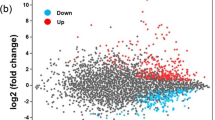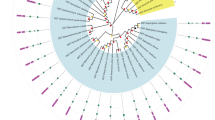Abstract
An ortholog of the response regulator protein Skn7 in Fusariumoxysporum f. sp. cubense race 4 (Foc4) was identified here and named FoSkn7. Mutants lacking FoSkn7 displayed higher sensitivity than the wild-type strain to oxidative stress. In addition, the FoSkn7-deletion mutant caused an oxidative burst in banana seedlings at early stages of infection and had reduced virulence on Giant Cavendish bananas (Musa spp.). These results showed that FoSkn7 confers resistance to exogenous oxidative stress. To understand the underlying mechanism of this resistance to exogenous oxidative stress, we used RNA-seq to identify genes that are differentially regulated between the FoSkn7-deletion mutant and the wild-type strain. Among 104 upregulated and 566 downregulated genes with a two-fold change cutoff, 26 downregulated genes were related to stimulus response and antioxidant activity. KEGG enrichment analysis showed that 150 differentially expressed genes were enriched in 67 metabolic pathways, mainly including ribosomes, ribosome biogenesis in eukaryotes, RNA polymerase, peroxisome, glutamate metabolism, fatty acid degradation, and protein processing in the endoplasmic reticulum. These results suggest that FoSkn7, as an important stress response regulator of Foc4, confers resistance to exogenous oxidative stress by regulating the expression of several stress-response- and antioxidant-related genes and metabolic pathways to promote the virulence of Foc4.







Similar content being viewed by others
References
Brown JL, North S, Bussey H (1993) SKN7, a yeast multicopy suppressor of a mutation affecting cell wall beta-glucan assembly, encodes a product with domains homologous to prokaryotic two-component regulators and to heat shock transcription factors. J Bacteriol 175:6908–6915
Brown JL, Bussey H, Stewart RC (1994) Yeast Skn7p functions in a eukaryotic two-component regulatory pathway. EMBO J 13:5186–5194
Cao C, Liu W, Li R (2009) Penicillium marneffei SKN7, a novel gene, could complement the hypersensitivity of S. cerevisiae skn7 disruptant strain to oxidative stress. Mycopathologia 168:23–30
Chen LH, Lin CH, Chung KR (2012) Roles for SKN7 response regulator in stress resistance, conidiation and virulence in the citrus pathogen Alternaria alternata. Fungal Genet Biol 49:802–813
Coenjaerts FE, Hoepelman AI, Scharringa J, Aarts M, Ellerbroek PM, Bevaart L, Van Strijp JA, Janbon G (2006) The Skn7 response regulator of Cryptococcus neoformansis involved in oxidative stress signalling and augments intracellular survival in endothelium. FEMS Yeast Res 6:652–661
Cuellar-Cruz M, Briones-Martin-del-Campo M, Cañas-Villamar I, Montalvo-Arredondo L, Riego-Ruiz IC, De Las Peñas A (2008) High resistance to oxidative stress in the fungal pathogen Candida glabrata is mediated by a single catalase, Cta1p, and is controlled by the transcription factors Yap1p, Skn7p, Msn2p, and Msn4p. Eukaryot Cell 7:814–825
Fassler JS, West AH (2011) Fungal Skn7 stress responses and their relationship to virulence. Eukaryot Cell 10:156–167
Gawel NJ, Jarret RL (1991) A modified CTAB DNA extraction procedure for Musa and Ipomoea. Mol Biol Rep 9:262–266
Geisbrecht BV, Zhu D, Gould SJ (1998) Molecular characterization of Saccharomyces cerevisiae Δ3, Δ2-enoyl-CoA isomerase. J Biol Chem 273:33184–33191
Grabherr MG, Haas BJ, Yassour M (2011) Full-length transcriptome assembly from RNA-seq data without a reference genome. Nat Biotechnol 29:644–652
Guo M, Guo W, Chen Y, Dong SM, Zhang X, Zhang HF (2010) The basic leucine zipper transcription factor Moatf1 mediates oxidative stress responses and is necessary for full virulence of the rice blast fungus Magnaporthe oryzae. Mol Plant-Microbe Interact 23:1053–1068
Guo M, Chen Y, Du Y, Dong YH, Guo W, Zhai S (2011) The bZIP transcription factor MoAP1 mediates the oxidative stress response and is critical for pathogenicity of the rice blast fungus Magnaporthe oryzae. PLoS Pathog 7:e1001302
Hagiwara D, Asano Y, Marui J, Furukawa K, Kanamaru K (2007) The SskA and SrrA response regulators are implicated in oxidative stress responses of hyphae and asexual spores in the phosphorelay signaling network of Aspergillus nidulans. Biosci Biotechnol Biochem 71:1003–1014
He XJ, Fassler JS (2005) Identification of novel Yap1p and Skn7p binding sites involved in the oxidative stress response of Saccharomyces cerevisiae. Mol Microbiol 58:1454–1467
Izumitsu K, Yoshimi A, Tanaka C (2007) Two-component response regulators Ssk1p and Skn7p additively regulate high-osmolarity adaptation and fungicide sensitivity in Cochliobolus heterostrophus. Eukaryot Cell 6:171–181
Izumitsu K, Yoshimi A, Hamada S, Morita A, Saitoh Y, Tanaka C (2009) Dic2 and Dic3 loci confer osmotic adaptation and fungicidal sensitivity independent of the HOG pathway in Cochliobolus heterostrophus. Mycol Res 113:1208–1215
Kalmar B, Greensmith L (2009) Induction of heat shock proteins for protection against oxidative stress. Adv Drug Deliv Rev 61:310–318
Kenneth JL, Thomas DS (2001) Analysis of relative gene expression data using real-time quantitative PCR and the 2-ΔΔCT method. Methods 25:402–408
Krems B, Charizanis C, Entian KD (1996) The response regulator-like protein Pos9/Skn7 of Saccharomyces cerevisiae is involved in oxidative stress resistance. Curr Genet 29:327–334
Kumar S, Stecher G, Tamura K (2016) MEGA7: Molecular evolutionary genetics analysis version 7.0 for bigger datasets. Mol Biol Evol 33:1870–1874
Larkin MA, Blackshields G, Brown NP, Chenna R, McGettigan PA, McWilliam H (2007) ClustalW and ClustalX version 2.0. Bioinformatics 23:2947–2948
Lee J, Godon C, Lagniel G, Spector D, Toledano MB (1999) Yap1 and Skn7 control two specialized oxidative stress response regulons in yeast. J Biol Chem 274:16040–16046
Li B, Dewey C (2011) RSEM: accurate transcript quantification from RNA-seq data with or without a reference genome. BMC Bioinf 12:323
Mao X, Cai T, Olyarchuk JG (2005) Automated genome annotation and pathway identification using the KEGG Orthology (KO) as a controlled vocabulary. Bioinformatics 21:3787–3793
Molina L, Kahmann R (2007) An Ustilago maydis gene involved in H2O2 detoxification is required for virulence. Plant Cell 19:2293–2309
Morgan BA, Banks GR, Toone WM, Raitt D, Kuge S, Johnston LH (1997) The Skn7 response regulator controls gene expression in the oxidative stress response of the budding yeast Saccharomyces cerevisiae. EMBO J 16:1035–1044
Motoyama T, Ochiai N, Morita M (2008) Involvement of putative response regulator genes of the rice blast fungus Magnaporthe oryzae in osmotic stress response, fungicide action, and pathogenicity. Curr Genet 54:185–195
Moye-Rowley WS (2003) Regulation of the transcriptional response to oxidative stress in fungi: similarities and differences. Eukaryot Cell 2:381–389
Mulford KE, Fassler JS (2011) Association of the Skn7 and Yap1 transcription factors in the Saccharomyces cerevisiae oxidative stress response. Eukaryot Cell 10:761–769
Parsell DA, Lindquist S (1993) The function of heat-shock proteins in stress tolerance: degradation and reactivation of damaged proteins. Annu Rev Genet 27:437–496
Ploetz RC (2006) Fusarium wilt of banana is caused by several pathogens referred to as Fusarium oxysporum f. sp. cubense. Phytopathology 96:653–656
Qi X, Guo L, Yang L, Huang J (2013) Foatf1, a bZIP transcription factor of Fusarium oxysporum f. sp. cubense, is involved in pathogenesis by regulating the oxidative stress responses of Cavendish banana (Musa spp.). Physiol Mol Plant Pathology 84:76–85
Qiu L, Pashkova N, Walker JR, Winistorfer S, Dhe-Paganon S (2010) Structure and function of the PLAA/Ufd3-p97/Cdc48 complex. J Biol Chem 285:365–372
Raitt DC, Johnson AL, Erkine AM, Makino K, Morgan B (2000) The Skn7 response regulator of Saccharomyces cerevisiae interacts with Hsf1 in vivo and is required for the induction of heat shock genes by oxidative stress. Mol Biol Cell 11:2335–2347
Ries L, Pullan ST, Delmas S, Malla S, Blythe MJ, Archer DB (2013) Genome-wide transcriptional response of Trichoderma reesei to lignocellulose using RNA sequencing and comparison with Aspergillus niger. BMC Genomics 14:541
Rokas A, Gibbons JG, Zhou X, Beauvais A, Latgé JP (2012) The diverse applications of RNA-seq for functional genomic studies in Aspergillus fumigatus. Ann N Y Acad Sci 1273:25–34
Saijo T, Miyazaki T, Izumikawa K (2010) Skn7p is involved in oxidative stress response and virulence of Candida glabrata. Mycopathologia 169:81–90
Shang Y, Chen P, Chen Y, Lu Y, Wang C (2015) MrSkn7 controls sporulation, cell wall integrity, autolysis, and virulence in Metarhizium robertsii. Eukaryot Cell 14:396–405
Soanes DM, Chakrabarti A, Paszkiewicz KH, Dawe AL, Talbot NJ (2012) Genome-wide transcriptional profiling of appressorium development by the rice blast fungus Magnaporthe oryzae. PLoS Pathog 8:e1003604
Tiwari S, Thakur R, Shankar J (2015) Role of heat-shock proteins in cellular function and in the biology of fungi. Biotechnol Res Int 2:1–11
Vargas-Peréz I, Sánchez O, Kawasaki L, Georgellis D, Aguirre J (2007) Response regulators SrrA and SskA are central components of a phosphorelay system involved in stress signal transduction and asexual sporulation in Aspergillus nidulans. Eukaryot Cell 6:1570–1583
Wang ZX, Zhou XZ, Meng HM (2014) Comparative transcriptomic analysis of the heat stress response in the filamentous fungus Metarhizium anisopliae using RNA-seq. Appl Microbiol Biotechnol 98:5589–5597
Wormley FL Jr, Heinrich G, Miller JL, Perfect JR, Cox GM (2005) Identification and characterization of an SKN7 homologue in Cryptococcus neoformans. Infect Immun 73:5022–5030
Young MD, Wakefield MJ, Smyth GK (2010) Gene ontology analysis for RNA-seq: accounting for selection bias. Genome Biol 11:R14
Zhang F, Xu G, Geng L (2016) The stress response regulator AflSkn7 influences morphological development, stress response, and pathogenicity in the fungus Aspergillus flavus. Toxins 8:202
Acknowledgments
This research was supported by the National Natural Science Foundation of China (Grant no. 31560491) and the Scientific Research Fund Project of Hainan University (kyqd1543).
Author information
Authors and Affiliations
Corresponding author
Ethics declarations
Conflicts of interest
The authors declare that they have no conflict of interest.
Research involving with human participants or animals
This article does not contain any studies with human participants or animals.
Additional information
Publisher’s Note
Springer Nature remains neutral with regard to jurisdictional claims in published maps and institutional affiliations.
Electronic supplementary material
Below is the link to the electronic supplementary material.
Rights and permissions
About this article
Cite this article
Qi, X., Liu, L. & Wang, J. Stress response regulator FoSkn7 participates in the pathogenicity of Fusariumoxysporum f. sp. cubense race 4 by conferring resistance to exogenous oxidative stress. J Gen Plant Pathol 85, 382–394 (2019). https://doi.org/10.1007/s10327-019-00858-6
Received:
Accepted:
Published:
Issue Date:
DOI: https://doi.org/10.1007/s10327-019-00858-6




